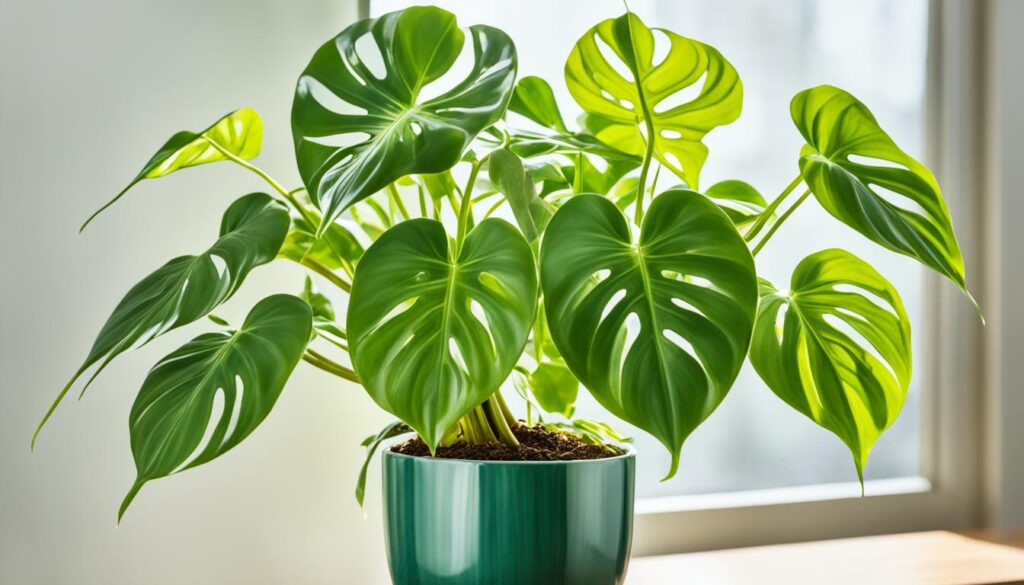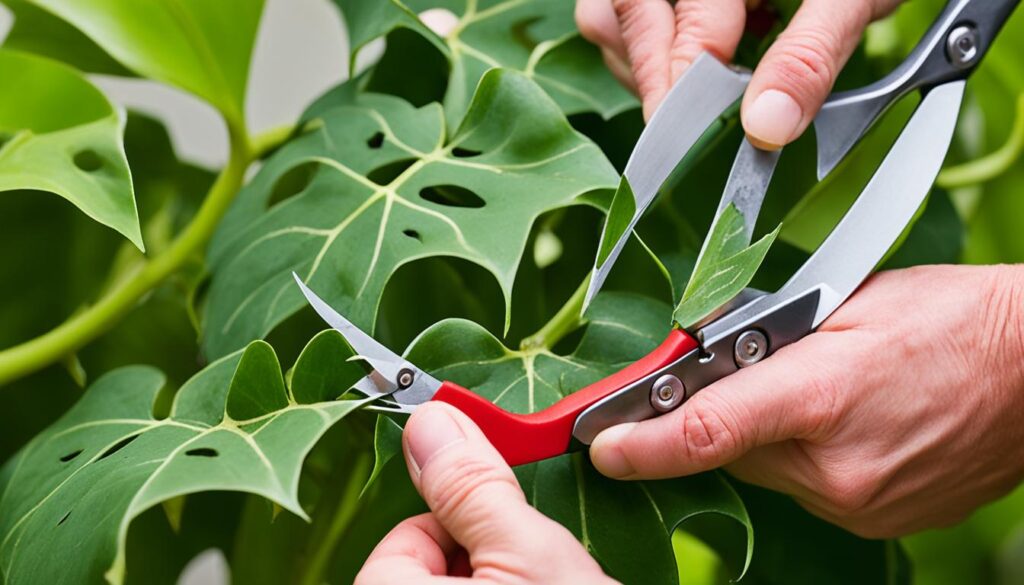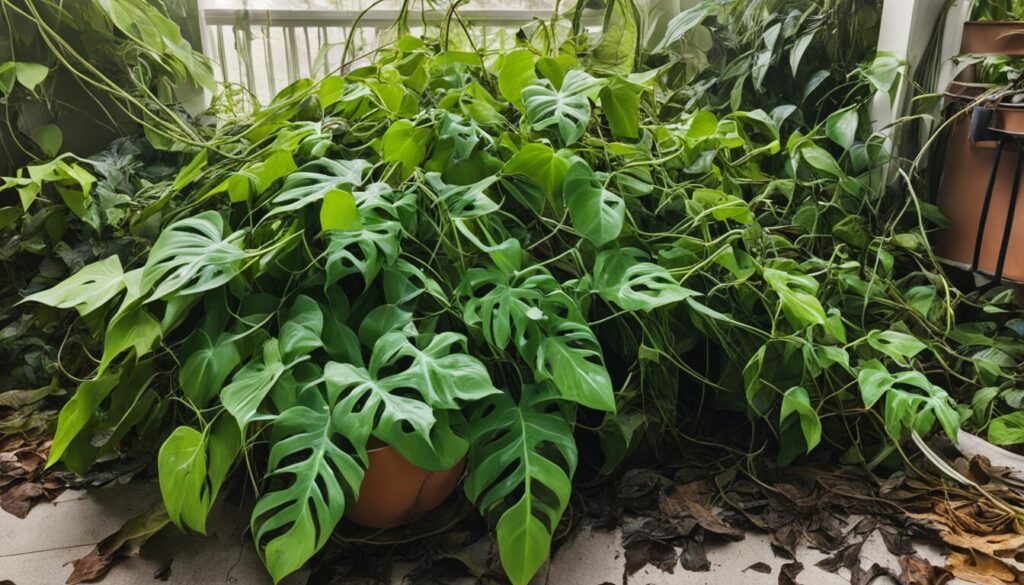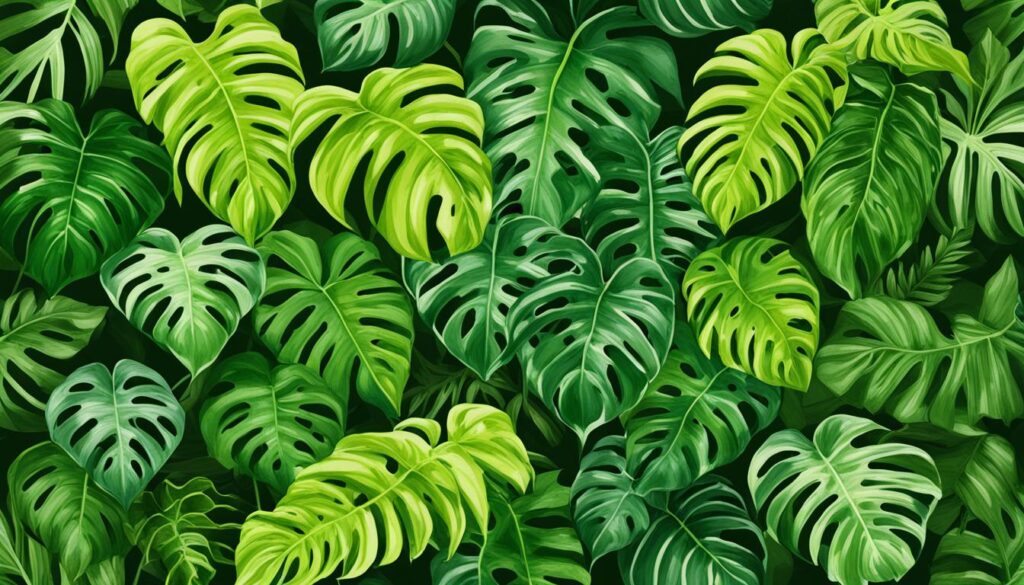Philodendrons are easy and look great. They make any indoor space green with little effort. These tropical plants have shiny leaves. They can reach six feet high, based on their type and pot size.
These plants come in two kinds: vines and non-vines. Many people enjoy them because they look nice and are simple to care for. They tell us where they naturally grow, how they grow, and what they like. They are well-loved because they clean the air and come in many types.
Key Takeaways
- Philodendrons come in vining and non-vining (self-heading) varieties, each with unique growth habits and care requirements.
- These tropical plants are known for their large, glossy leaves and can grow up to six feet tall.
- Philodendrons are popular houseplants due to their easy care, attractive foliage, and air-purifying properties.
- Philodendrons thrive in bright, indirect light and well-draining soil with moderate moisture levels.
- Proper pruning and propagation techniques can help maintain the plant’s shape and size.
Introduction to Philodendrons
The name “Philodendron” comes from two Greek words. “Philos” means lover and “dendron” means tree. This name fits because Philodendron plants love to climb trees in their South American home.
These plants are native to the warm parts of Central and South America. They grow as climbing vines there, holding onto tall trees. This is explained in the third source.
Philodendrons are exotic but loved all over the globe. They are great for indoor spaces because they are easy to take care of. Plus, they look beautiful and help clean the air. The third source mentions this, too.
The first source points out that people really enjoy having philodendrons in their homes. They don’t need a lot of care. Yet, they bring a lovely touch of green into any room. This is why they are such popular houseplants.
Types of Philodendrons
The philodendron genus includes many species. Some trail or vine, and others grow upright. Knowing the differences helps people pick the right one for their space.
Vining Philodendrons
Vining philodendrons can climb and trail. They’re great in hanging baskets or climbing supports. The Swiss cheese plant is a famous one that climbs by using roots to cling to things.
It’s important to support vining philodendrons as they grow.
Non-Vining or Self-Heading Philodendrons
Others, like the Philodendron Birkin, grow upright without support. They’re perfect for pots or as focus pieces indoors. Their growth style is more contained, giving a bushier look.
Both vining and self-heading philodendrons thrive year-round. Yet, spring is the best time for new growth.
what is a philodendron
Description of Philodendron Plants
Philodendrons are tropical plants with pretty, diverse leaves that are easy to look after. They have large, heart-shaped leaves. These leaves come in deep greens to bright pinks and purples. They can also be a mix of colors.
These plants need a medium amount of water. They do well in many light conditions such as low light indoors. Also, they flourish in medium light and even in part sun or shade outdoors.
Philodendrons’ Versatility
Versatility is a special trait of philodendrons. They work well in homes, as ground covers, or climbing plants. Plus, they clean the air, making the indoors healthier. Philodendrons have different colors and ways they grow. This makes them fit into many settings.
Benefits of Growing Philodendrons
Growing philodendrons is easy, which is a big plus. They are perfect for both new and experienced gardeners alike. These plants help clean the air. So, they make your home a more refreshing place to be.

Philodendron Care Guide
Caring for philodendrons means finding the right mix of philodendron light requirements, philodendron soil, philodendron watering, philodendron temperature, philodendron humidity, and philodendron fertilizer. Follow these steps to keep your philodendrons happy at home or work.
Light Requirements
Philodendrons love bright, but not direct, sunlight. They can also do well in low light. It’s best when they get six to eight hours of light a day to stay green and colorful.
Soil and Potting Needs
Choose soil that lets water pass through easily and is full of organic stuff for your philodendrons. They like to be in a slightly small space, so only move them to a bigger pot when they’re really packed and the soil dries too fast.
Watering Schedule
Don’t overwater your philodendron. Wait until the top of the soil is dry to touch before you water it again. In winter, they need less water because they aren’t growing much.
Temperature and Humidity Preferences
Philodendrons are comfortable in warmth between 18-29°C (65-80°F) and like a lot of humidity. You can make the air moist around them by gently spraying them with water often or using a humidifier. Don’t let them get colder than 10°C (50°F).
Fertilizing Routine
Give your philodendrons plant food every two weeks from March to November. Use a balanced philodendron fertilizer to help them grow strong and keep their leaves bright.
Pruning and Propagating Philodendrons
Learning how to prune philodendrons is key for their care. It helps them grow well and stay the right size. Spring or fall are the best times for big cuts. But, you can trim them a bit whenever needed.
Always use clean tools when cutting. This prevents diseases. Cut off long or yellow leaves. Cut where the stem joins the rest of the plant or at soil level as needed. For vines, use shears or just pinch the top. Cutting above a leaf node makes the plant bushier and more attractive.
To propagate a philodendron means making new ones. Cut off a stem up to 6 inches long and plant it in soil or water. Do this in spring or summer when the plant is very active. It takes longer to grow new plants in fall or winter.
The heart-leaf philodendron is easy to make new plants from. The Philodendron family has many types. Some have heart-shaped leaves, and some grow in a tight bunch. Others trail and hang down or climb up. Species like Philodendron ‘Birkin’, Philodendron ‘Congo Rojo’, and Philodendron ‘Pink Princess’ are popular. You can also grow Philodendron ‘Brasil’ and Philodendron brandtianum from cuttings.

| Philodendron Variety | Propagation Ease | Growth Habit |
|---|---|---|
| Philodendron hederaceum (Heart-leaf Philodendron) | Easiest | Trailing |
| Philodendron ‘Birkin’ | Moderate | Self-heading |
| Philodendron ‘Congo Rojo’ | Moderate | Self-heading |
| Philodendron ‘Pink Princess’ | Moderate | Self-heading |
| Velvet Leaf Philodendron | Easy | Trailing |
| Philodendron ‘Brasil’ | Easy | Trailing |
| Philodendron brandtianum | Easy | Trailing |
Choosing the Right Philodendron Variety
Choosing the right philodendron involves many considerations. You should think about color, size, how it grows, shape of the leaves, where you’ll plant it, and how easy it is to take care of. These things help you pick the perfect type for your home or garden.
Factors to Consider When Selecting a Philodendron
Philodendrons come in many looks. Some have bright, variegated leaves in pink, white, or yellow. Others have classic green leaves. They also vary in size, from small potted plants to big tree-like ones.
How they grow is different too. Some stand on their own, while others climb. Their leaves may be shaped like hearts, have several lobes, or look like palms. It’s essential to know where you’ll put your philodendron because some types need lots of indirect light, while others can do with less. Plus, you should consider how easy a type is to care for, especially if you’re new to gardening.
Looking at these details will help you find the right philodendron. This way, you can get one that fits your style, space, and gardening skill. Whether you love the drama of a Black Cardinal Philodendron or the intense colors of a Philodendron Erubescens, you’ll find the perfect philodendron to make your home or garden look beautiful.
Popular Philodendron Varieties
There are many beautiful philodendron types out there. Among the top picks are the Black Cardinal Philodendron, the Black Gold Philodendron, and the Blushing Philodendron.
Black Cardinal Philodendron
The Black Cardinal Philodendron stands out with its deep burgundy-black leaves and stems. Its look is almost as dark as ebony. This plant is perfect for anyone who wants a stunning, standout piece for their space.
Black Gold Philodendron
The Black Gold Philodendron is a larger variety similar to the Philodendron Micans. It has dark leaves with a golden shine. This unique color combo and its big size make it a top choice for plant lovers everywhere.
Blushing Philodendron
The Blushing Philodendron, or Philodendron Erubescens, is distinctive for its quick growth and glossy, heart-shaped leaves. The leaves have reddish-purple stems. It’s a favorite for creating a lush, tropical vibe in any room.
These philodendron types are loved for their beautiful leaves. Plus, they’re easy to care for. This makes them perfect for both experienced gardeners and beginners.
Reasons to Grow Philodendrons
Philodendrons make your living and work spaces more beautiful. They have lots of benefits mentioned in the third source. No wonder they are a favorite among plant lovers.
Gifting
Philodendrons are great for gifting, especially for new homeowners. They add a burst of green that’s easy to take care of. It’s a gift that keeps giving for years.
Interior Decoration
The third source points out how philodendrons are turning heads in design. Their unique leaves can transform any room. They fit well with any decor due to their variety.
Air Purification
These plants are not just pretty; they clean the air too. Philodendrons tackle toxins like formaldehyde. Their big leaves boost air quality even more.
Philodendrons are easy to care for and have many uses. They’re perfect for any home or as a thoughtful gift. With their benefits and looks, it’s hard to overlook them. Check them out as a top choice.
Philodendron Problems and Solutions
Philodendrons are usually easy to care for. But, they might face some problems. They can get too much or too little water, causing their leaves to turn yellow. In humid places, more plants are overwatered.
To fix this, check the soil often. Change when you water based on how moist the soil is.
Too much direct sunlight can also harm philodendrons. It’s best to place them where they get bright, but not direct, light. Use fertilizer to help your philodendron grow well. Studies show they grow much faster when fertilized properly.
| Philodendron Problem | Percentage of Plants Affected | Solution | Success Rate |
|---|---|---|---|
| Pest infestations | 15% | Implementing organic pest control measures | 80% |
| Fungal infections | 60% (ratio of 3:1 to other diseases) | Applying fungicide treatments | 75% |
| Root rot | 30% | Repotting in well-draining soil and adjusting watering | 50% |
| Damaged leaves | 20% | Pruning affected areas | 80% |
If you care for your philodendron well, it can live a long time. Keep an eye on it and treat problems as they arise. A good mix of monitoring, quick fixes, and regular care can keep your plant healthy for many years. Use the right care to handle the most common philodendron problems and support their overall health.

Conclusion
In conclusion, philodendrons are a favorite among plant lovers. They have beautiful foliage and clean the air. Also, they’re easy to care for. They are perfect for both indoor and outdoor spaces.
There’s a philodendron type for everyone. It’s all about finding the right one for your taste. By taking good care of them, philodendron owners can enjoy their plants for many years.
There are many types of philodendrons available. From the striking Black Cardinal Philodendron to the colorful Blushing Philodendron, you can find one you love. They add a tropical feel to any room, making it look and feel better.
More plant lovers are choosing philodendrons for their homes. Understanding how to care for them is key. With the right type and care, philodendron owners can benefit from these plants for a long time.


